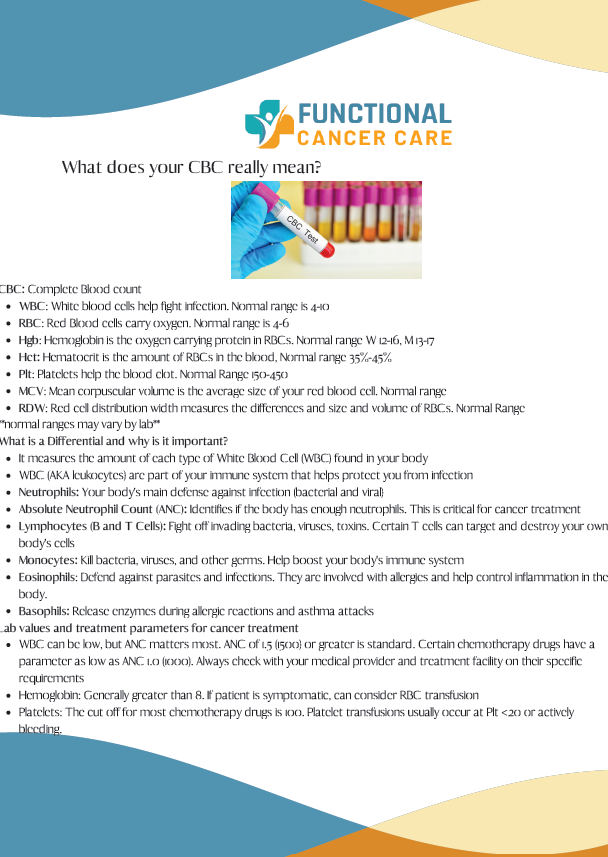Here's How to Interpret Your Complete Blood Count (CBC ) Results
Do you ever stalk your labs in your online portal, anxiously awaiting the results? Then you get them back and upon your review, you see numbers highlighted in red or an H or L next to it and this sends you into a spiral of panic?
Does your provider try to reassure you that the results are normal or within range for cancer treatment, but he/she never takes the time to fully review the results with you?
Well I'm here to tell you how to interpret your own CBC confidently. A CBC is a complete blood count and it is important for general health as well as cancer treatment. The CBC is very important and can help determine if your blood counts are adequate for chemotherapy or cancer directed therapy. Many of these treatments impact the blood counts significantly (really the bone marrow, where you make all of your cell lines) and thus, your CBC can fall outside of treatment parameters.
It is imperative that we follow treatment parameters regarding your blood counts, so that we treat you safely without doing serious harm. If we treat you with blood counts outside of parameters, we risk infection, bleeding, and possible hospitalization. Nobody wants an extra visit to the hospital when you are in the middle of cancer treatment.
Let’s review the CBC in detail so you have a better understanding of what all these numbers really mean in the context of your cancer treatment.
The white blood cells help fight infection while the red blood cells circulate oxygen. Hemoglobin is a protein that carries the oxygen and hematocrit is the percentage by volume of the number of red blood cells in your blood. The platelets help your blood clot.
The white blood cell is made up of multiple different parts. This is called the differential that you may see on your CBC report. It includes the neutrophils, lymphocytes, monocytes, basophils, and eosinophils.
The various parts of the differential are important because they can help fight viruses, infections, and they react when you're having an allergic response.
WBC and ANC
White blood cells are critical for your treatment. A typical normal range is 4-10, but please note, every lab has a different normal range. You may get a result of WBC 1.9 and be disappointed thinking you can not receive treatment with WBC count so low. Here is where the neutrophil count comes into play and is even more critical. The Neutrophils are the part of the white blood cell that helps fight infection. Generally, the absolute neutrophil count must be at least 1.5 or 1500 to safely get chemotherapy. There are some chemotherapy drugs that can be administered with an ANC of 1 to 1.2, but typically this is at the discretion of your treating provider and cancer center pharmacist.
If your WBC/ANC are consistently low, we can prescribe GCSF (Granulocyte colony stimulating factor) to be given post chemotherapy. There is a long acting version, Neulasta (or biosimilar) or short acting version known as neupogen (or biosimilar) that can be administered by injection. Neulasta is usually given 24-72 hours post chemotherapy and neupogen is also administered starting 24 hours post chemotherapy, but usually given over 5-7 days. These medications help to stimulate your bone marrow to produce more WBCs and thus, prevent infection and keep your treatment on a routine schedule.
HEMOGLOBIN
We also focus on hemoglobin. A normal range for women is 12-16 and for men 13-17. Many chemotherapy drugs will cause the hemoglobin to drop and you may continue to see a drop every cycle as the impact of chemotherapy is cumulative. I personally prefer to keep my patients hemoglobin above 9 or 10 if possible. It is also important to consider comorbidities such as cardiovascular disease as this can change your treatment parameters. If your hemoglobin drops below 8 and you are feeling symptomatic with dizziness, shortness of breath, and fatigue, your provider should consider a blood transfusion. Some cancer centers have changed their hemoglobin guidelines to below <7 in order to receive a blood transfusion. If a patient is elderly or has a cardiac condition, consider blood transfusion at hemoglobin higher than 7-8 or with acute symptoms.
PLATELETS
Platelets are another piece of the puzzle. A typical normal range for platelets is 150-450. Most chemotherapy guidelines indicate a platelet count of >100 for treatment to occur. However, your provider might make an exception to treat with lower platelets depending on the specific drug being used and your platelet trend over time. The risk of administering chemotherapy with low platelets is that it can lead to bleeding and bruising. I always remind patients if they have low platelets, fall and acquire a head injury, this means an automatic trip to the ER to rule out a brain bleed. In terms of platelet transfusions, most facilities do not administer platelets below 20 and often times 10, unless active bleeding.
As mentioned above, we focus a great deal on the neutrophils and try to ensure they remain adequate for safe administration of chemotherapy.
Please download my quick guide on “What does your CBC really mean?" by clicking the image below”



